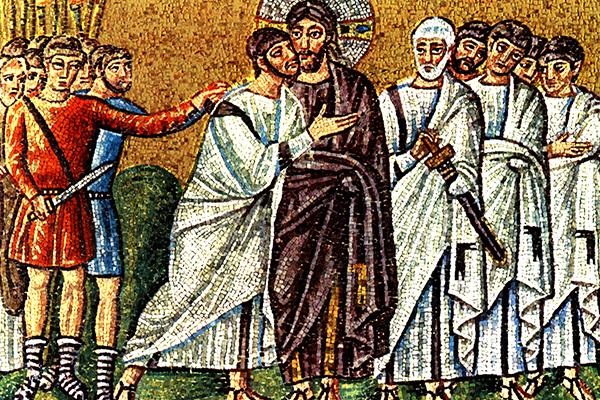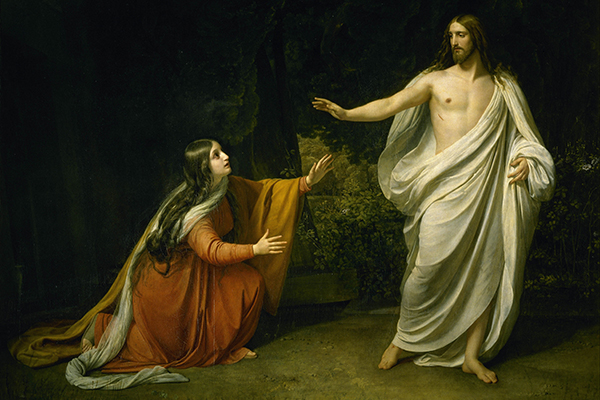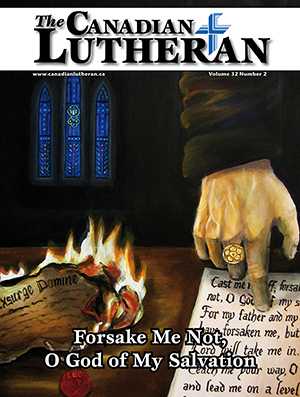Missing Jesus

Judas betrays Jesus to the band of soldiers. Peter prepares to draw his sword. (Mosaic from the Basilica of Sant’ Apollinare Nuovo in Ravena, Italy).
by Mathew Block
If anyone should have understood Jesus, it was Judas. A disciple of the Lord, He had heard the teachings and seen the miracles. But on the night he betrays Jesus, we see how little he truly knew Him.
We read that Judas leads out “a band of soldiers and some officers from the chief priests and the Pharisees” against Jesus, carrying with them “lanterns and torches and weapons” (John 18:3). We further read that the “great crowd” is armed with “swords and clubs” (Matthew 26:47). A confrontation is clearly expected.
“Whom do you seek?” the Lord asks. They tell Him they want Jesus of Nazareth. “I am He,” He says (John 18:4-5). But rather than arrest him, they shrink back. Something about Jesus and His answer—I am He—gives them pause. The Jesus they meet, it seems, is not the Jesus they were expecting. These armed soldiers stand uncertain before the unarmed Jesus.
Something about Jesus and His answer—I am He—gives the soldiers pause. The Jesus they meet, it seems, is not the Jesus they were expecting.
Judas should have known that Jesus would make no resistance. “Have you come out as against a robber,” Jesus asks in surprise, “with swords and clubs to capture me?” (Mark 14:48). The answer should be no: Jesus is no insurrectionist. And yet there Judas is with an army at his back.
He is not alone in misunderstanding Jesus. The other disciples likewise fail to understand Him here, asking whether they should draw their swords. Peter even strikes off the ear of a servant of the high priest. But Jesus rebukes Peter and heals the injured man. Only then is He finally arrested.
Neither Judas nor the other disciples, it seems, truly understand who Jesus is. They expect Him to try for an earthly throne—to fight for His life. Instead, they find a lamb who walks willingly to the slaughter.
The confusion over Jesus continues throughout the crucifixion story. The council of priests are looking for a blasphemer; they find One in whose mouth no deceit can be found (1 Peter 2:22). Pilate is looking for a criminal (John 18:29, 35); he finds a King (18:36-37). And more than a king—he finds the Son of God (19:7). Everyone in the story misses who Jesus really is. They are prisoners to their own expectations. And so it is that Jesus is led out to Golgotha to be crucified.

Jesus appears to Mary Magdalene following the resurrection. (Painting by Alexander Ivanov, 1835)
The confusion continues into the resurrection story too. “On the first day of the week,” we read, “Mary Magdalene came to the tomb early, while it was still dark, and saw that the stone had been taken away from the tomb” (John 20:1).
She has come to anoint the body with spices—to find, in other words, a corpse. What she finds instead is an empty tomb. In confusion, she runs and tells Peter and John, who come and confirm the tomb is empty.
They return at length to their own homes, but Mary remains. “Mary stood weeping outside the tomb,” we read, “and as she wept she stooped to look into the tomb” (John 20:11). Two angels ask whom she is seeking. She responds that she is looking for the body of the Lord. Then Jesus Himself appears behind her. “Woman, why are you weeping?” He asks. “Whom are you seeking?” (John 20:15). But she does not recognize Him. She mistakes Him for a gardener and asks again about the body. Finally, Jesus calls her by name and at last she understands.
We do not always see Jesus for who He is. In moments like these, we need Him to call us by name as He called Mary—to open our eyes. Only then can we see Him for who He is: our Saviour.
We do not always see Jesus for who He is. In moments like these, we need Him to call us by name as He called Mary—to open our eyes.
Christ does that for you in Scripture. There He gives you the testimony of those who have seen and understood Jesus. He speaks to you even now through their words. St. Mary Magdalene did the same for the disciples when she told them Jesus was risen. The disciples in their turn told others, and down it has gone through the ages. In his gospel, St. John writes that he is an eyewitness to the events in question, and He shares them with you that you also may believe (John 19:35)—“and that by believing you may have life in His name” (20:31).
 In the same way, we celebrate the testimony of those who have gone before us for reminding us who Christ really is. To that end, we consider anew the Apostle’s Creed in this issue of The Canadian Lutheran, and its faithful witness to Christ down through the centuries. We remember also the Easter-focused faith of Martin Luther and its continuing witness to Christ.
In the same way, we celebrate the testimony of those who have gone before us for reminding us who Christ really is. To that end, we consider anew the Apostle’s Creed in this issue of The Canadian Lutheran, and its faithful witness to Christ down through the centuries. We remember also the Easter-focused faith of Martin Luther and its continuing witness to Christ.
It is in that sense that we celebrate the 500th anniversary of the Reformation this year, as President Robert Bugbee explains. We’re not celebrating Luther for the sake of Luther. But like the writers of the Apostle’s Creed, like St. John and the other Gospel writers, like St. Mary Magdalene at the tomb, Luther and the other reformers stand as witnesses to Christ. They help us to see Jesus as He is: the crucified and risen One, Son of God, and Saviour of the world—Saviour even of us who sometimes fail to see Him as we ought.
———————
Mathew Block is communications manager for Lutheran Church–Canada and editor of The Canadian Lutheran. He also serves as editor for the International Lutheran Council’s news service.



